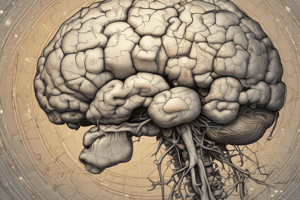Podcast
Questions and Answers
What is the primary reason for the problems caused by a brain tumor growing inside the skull?
What is the primary reason for the problems caused by a brain tumor growing inside the skull?
- The increase in intra cranial pressure damages the brain (correct)
- The buildup of extra cells forms a mass of tissue
- The tumor replaces normal cells in the brain
- The rigid skull restricts the growth of the tumor
What is the percentage of primary brain tumors that are Meningioma, a benign primary tumor?
What is the percentage of primary brain tumors that are Meningioma, a benign primary tumor?
- 20.8%
- 25.5%
- 17.1%
- 33.8% (correct)
According to the 2010 data, what is the age range of adults where brain tumors typically occur?
According to the 2010 data, what is the age range of adults where brain tumors typically occur?
- 2nd to 4th decade
- 4th to 6th decade
- 5th to 7th decade (correct)
- 3rd to 5th decade
What is the location of the largest percentage of childhood tumors?
What is the location of the largest percentage of childhood tumors?
In what year did the World Health Organization (WHO) first publish a universal classification system for CNS tumors?
In what year did the World Health Organization (WHO) first publish a universal classification system for CNS tumors?
What is the primary characteristic that distinguishes primary brain tumors from secondary brain tumors?
What is the primary characteristic that distinguishes primary brain tumors from secondary brain tumors?
What is a characteristic of benign brain tumors that is not typical of benign tumors in other parts of the body?
What is a characteristic of benign brain tumors that is not typical of benign tumors in other parts of the body?
What is a key difference between benign and malignant brain tumors in terms of their growth patterns?
What is a key difference between benign and malignant brain tumors in terms of their growth patterns?
What is a potential consequence of a benign brain tumor?
What is a potential consequence of a benign brain tumor?
What is a characteristic of malignant brain tumors in terms of their spread?
What is a characteristic of malignant brain tumors in terms of their spread?
Flashcards are hidden until you start studying




